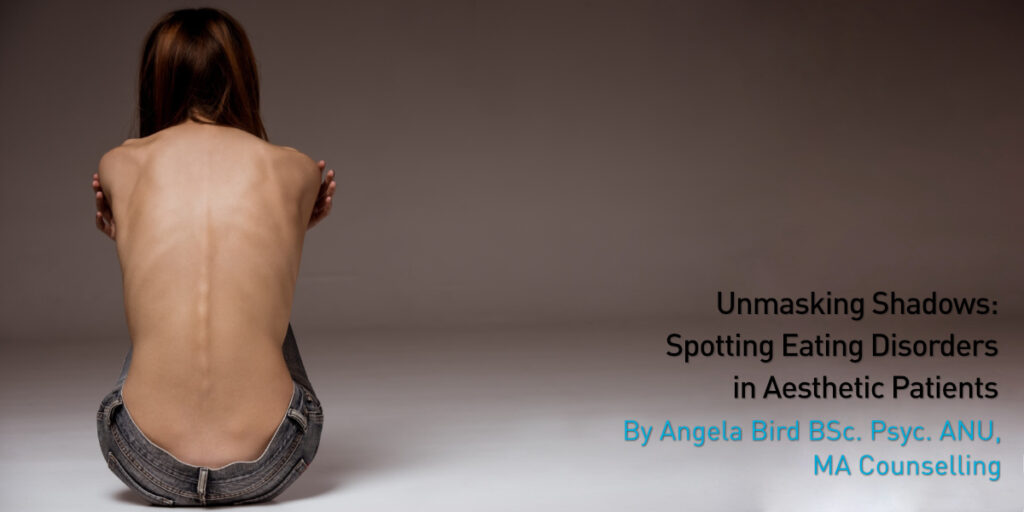Unmasking Shadows: Spotting Eating Disorders in Aesthetic Patients

For those of you currenting working in the field of aesthetics, you’ll be familiar with Ahpra’s ‘Guidelines for medical practitioners who perform cosmetic surgery and procedures’ released 1 July 2023. Clause 2 of the Guidelines, ‘Assessment of patient suitability’, draws our attention to BDD and eating disorders. This blog dives into a topic that’s been lingering in the shadows of the beauty industry: eating disorders among aesthetic patients. Yes, it’s a real concern that’s silently making its mark, and it’s time we shed some light on it.
So, what are eating disorders, you ask? Well, they’re not just about dieting or quirky eating habits. According to the experts, it’s when your eating game is seriously messing with your health or how you function socially (American Psychiatric Association, 2013). And get this: over a million Aussies are dealing with this stuff every year (Hay et al., 2023, NEDC, nd).
Now, we all love a good beauty makeover, right? But here’s the catch: some clients might never be satisfied with any procedure. It’s like a never-ending quest for perfection (Vashi, 2016). In this blog, we will explore the subtle signs and talk about how beauty pros like us can handle the delicate dance between aesthetics and mental health.
Walking the Tightrope Between Beauty and Disorder
Let’s face it – the pressure to meet societal beauty standards can push some folks into a not-so-healthy lifestyle. Sure, a bit of concern about how we look is normal, but when it becomes an obsession, we might be dealing with a bigger issue (Vashi, 2016). And guess what? Eating disorders often come hand in hand with mental health problems like depression and anxiety (Tan et al., 2023).
Ever heard of Body Dysmorphic Disorder (BDD)? It’s a perfection-focused eating disorder that might make clients unhappy with their appearance even after getting cosmetic treatments (Kelly et al., 2021). Crazy, right? And here’s the kicker – research shows that those with BDD who get cosmetic surgery don’t see any improvement in their symptoms (Phillips et al., 2001). Talk about a tricky situation for therapists trying to help clients with undiagnosed eating disorders!
And it’s not just a female thing. Guys are feeling the pressure, too. Studies suggest that about 3.5% of dudes have dealt with binge eating disorder (Hudson et al., 2007). Plus, there’s a whole mess of issues starting early in life. Kids as young as six are expressing concerns about their weight (Favaro et al., 2009). Social media isn’t helping, either. Platforms like Instagram and TikTok are fuelling the fire, making someone you know probably struggle with some form of an eating disorder.
The Beauty Pro’s Playbook
Alright, beauty pros, listen up! We’re the front line in creating a safe space for our clients. We might not be mental health experts, but we can be the early detectors of eating disorders. Open communication and a non-judgmental attitude are our secret weapons.
Feeling unsure about bringing up your concerns? No worries. There’s a helpline – the Butterfly Foundation National helpline. They’re there to offer free and confidential support. Now, let’s talk about what to look out for in your clients:
- Weight Whirlwinds: Sudden and extreme weight changes might signal something deeper. Distinguish between intentional and potentially unhealthy changes.
- Image Obsession: Keep an eye on clients overly fixated on their looks. Non-stop dissatisfaction and a never-ending quest for perfection could be red flags.
- Exercise Overload: Too much exercise, especially when paired with restrictive eating, is a red flag. Talk to your clients about their routines and note any extreme behaviour.
- Eating Habits Haywire: Watch for irregular eating patterns – skipping meals, food group avoidance, or anxiety about food choices. These could point to an unhealthy relationship with food.
Your Action Plan
Educate yourself on the signs and symptoms of eating disorders. Check out reliable sources like NEDA or NEDC for education, insights and fact sheets. Remember, creating a judgment-free zone is key. Clients might be dealing with shame or fear, so let’s build an atmosphere of trust.
If you suspect a client is struggling, nudge them towards mental health professionals. The Butterfly Association is a fantastic referral source. Make a list of specialists in your area to enhance your client service.
Our duty as professionals goes beyond the surface. Identifying potential eating disorders and addressing them with empathy is crucial. By creating a supportive environment and staying informed, we contribute to the overall well-being of those we serve. Let’s aim for beauty that radiates not just from the outside but from a foundation of health and self-love. 💖✨
Further Information for Pending Students
If you’re considering a career in aesthetics, AACDS offers the following nationally accredited qualifications:
Undergraduate
Advanced Diploma of Cosmetic Dermal Science
Postgraduate
Graduate Diploma of Cosmetic Nursing and Injectables
Graduate Diploma of Dermal Science
Graduate Certificate in Cosmetic Medicine

